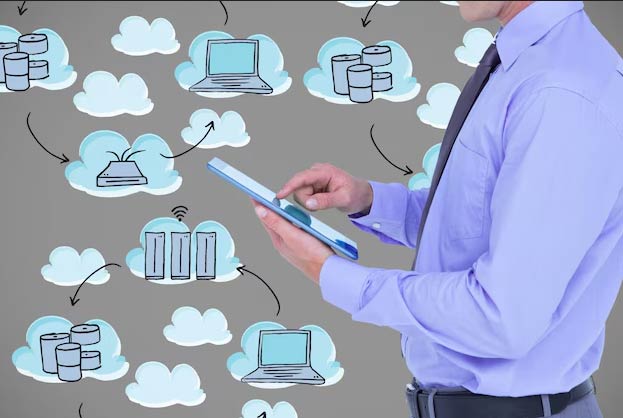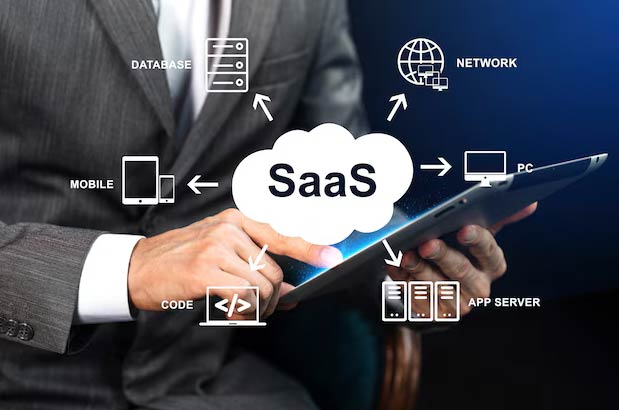Difference Between SaaS And ERP: Comparison, Deployment Models & Business Fit
Now imagine your company spends millions on some giant software that controls inventory, payroll, manufacturing, everything… and it still breaks every second Tuesday. That’s the vibe difference we’re talking about today.
Many CTOs and CEOs keep googling about the difference between SaaS and ERP and end up getting confused. So let’s break it down in a way that actually makes sense.
Read on to know what is difference between SaaS and ERP systems.

Difference Between Saas And ERP
ERP is a business management system. It focuses on functions like finance, inventory, procurement, production, and HR. It’s the software that runs your operations.
SaaS is a delivery model. It’s about how the software is accessed: through a subscription, over the internet, without managing servers. You don’t install anything. You just log in and use it.
Think of it like this:
SaaS is Uber. ERP is owning and running a whole trucking company.
You can totally have Uber for trucks (that’s SaaS ERP), but most big companies use now, but you can also have your own fleet of trucks parked in your garage (old-school on-premise ERP).
Here’s an everyday example to understand better:
You use Gmail, Canva, Zoom — all SaaS. None is an ERP. But a billing system in a drug store for sales and payment collection - that’s ERP.
So:
All SaaS ERP is SaaS.
Not all SaaS is ERP.
Most ERP today is SaaS, but it doesn’t have to be.
Here’s the difference between SaaS and ERP:
| Feature / Point of Comparison | ERP | SaaS |
| Meaning | Business system that manages finance, inventory, HR, supply chain, and operations | Subscription-based software delivered online |
| Focus | Functions and processes | Delivery and access |
| Ownership | Company often owns licences or instance | Vendor owns and manages everything |
| Installation | Can be on-prem or hosted | No installation, accessed via browser |
| Implementation Time | A few days or weeks | 12-24 months |
| Updates | Controlled by the company | Automatic, handled by vendor |
| Infrastructure | Company or hosting partner manages servers | Vendor manages entire environment |
| Customisation | Deep, extensive, tailored | More standardised but improving |
| Cost Model | Licence cost + maintenance | Monthly or yearly subscription |
| Access | Depends on setup (local or remote) | Accessible from anywhere via internet |
| Examples | SAP ECC, Oracle EBS, Microsoft Dynamics | Gmail, Slack, Canva, Salesforce |
| Example of SaaS ERP | NetSuite ERP, SAP Business ByDesign | — |
| Is ERP the same as SaaS? | No, ERP is an application | No, SaaS is a delivery model |
| Can ERP be SaaS? | Yes, if delivered as SaaS ERP | — |
| Use Case | Complex workflows, deep integrations | Fast deployment, easy scaling |
How Do You Compare ERP Vs Saas For Different Workflows?
It’s never “which is better.” It’s “which fits my exact mess right now?” In fact, it totally depends on what your company actually does every day.
Need deep manufacturing, inventory, and traceability across 27 plants? Classic ERP wins (especially if you’re heavily customized).
Need finance, HR, and CRM yesterday with almost zero IT team? SaaS ERP (or even separate SaaS tools) wins.
Growing fast and hate big upfront costs? SaaS all day.
Running complex bill-of-materials and need total control over every field? On-premise or private-cloud ERP still rules.
Where SaaS wins
Fast-growing startups
Global teams who need remote access
Companies with small IT teams
Businesses needing quick rollout across departments
Where traditional ERP wins
Manufacturers needing deep shop-floor customisation
Companies with strict data-residency rules
Organisations that already run a large IT setup
Workflows that require heavy integrations and custom logic
How Do Saas Deployments Compare To On-Premise ERP Systems?
Here’s the classic showdown everyone still asks about in boardrooms:
| Factor | On-Premise ERP | SaaS ERP |
| Upfront cost | Millions | Almost zero |
| Monthly/annual cost | Lower (after year 3–5) | Higher forever (but predictable) |
| Implementation time | 12–36 months | 3–12 months |
| Updates | You decide when (painful) | Automatic every quarter (you just deal) |
| Customization | Unlimited | Limited but growing |
| Data control | 100% yours on your servers | Vendor’s cloud (but encrypted) |
| Scalability | Buy new servers | Flip a switch |
A fashion brand (client of ours) started with Shopify + Dear Inventory + Xero + A million Zapier recipes. Every Black Friday, something broke. The inventory was wrong by 8–12%. Switched to Ekklavya SaaS ERP last year. First Black Friday with zero stock-outs and actual profit numbers by 9 a.m. Saturday.

How Does Saas ERP Differ From Cloud ERP?
People often mix up the two. All SaaS solutions run on the cloud, but not all cloud ERP solution is SaaS. It simply sits on top of whichever layer you choose.
In software service models, infrastructure is IaaS, development platforms are PaaS, and ready-to-use applications are SaaS. ERP is often misclassified because people assume that anything cloud-based is automatically SaaS.
In reality, the difference comes from how the software is hosted, managed, and delivered.
| Type | Hosting | Updates | Customization | Pricing | Example |
| SaaS ERP | Vendor’s multi-tenant cloud | Forced & automatic | Medium (configs + light code) | Per user/month, all included | NetSuite, Acumatica, Odoo Online |
| Private Cloud ERP | Your own/private cloud instance | You choose | High (almost unlimited) | Big license + hosting fees | SAP on AWS, Oracle Cloud Infrastructure (dedicated) |
| Hosted On-Premise | Vendor hosts your on-prem license | You choose | Unlimited | License + hosting | Microsoft Dynamics GP hosted |
So when someone says “we run cloud ERP,” always ask: “Multi-tenant SaaS or your own instance?”
The answer changes everything about cost, speed, and future headaches.
How Do ERP And Saas Fit Into Software Classification Models?
ERP is an application. SaaS is a software delivery model. That means ERP can be delivered as SaaS, but ERP itself is not SaaS or PaaS. It simply sits on top of whichever layer you choose.
In software service models, infrastructure is IaaS, development platforms are PaaS, and ready-to-use applications are SaaS. ERP often gets misclassified because people assume anything cloud-based is automatically SaaS. In reality, the difference comes from how the software is hosted, managed, and delivered.

How Do Cloud, On-Premise, Saas, And Hybrid Models Compare Theoretically?
Here is the difference between SaaS, cloud, on-premise and hybrid models:
On-premise ERP - Traditional deployment of software on the company's own servers and infrastructure. The customer owns the licenses, hardware, and full responsibility for everything.
Cloud ERP - They are hosted in the cloud on dedicated/virtual servers. The customer owns/rents the instances, but the infrastructure is controlled by a cloud provider.
SaaS - The model where the ERP is fully cloud-native, multi-tenant, hosted and managed 100% by the vendor.
Hybrid ERP - A combination of the above. Core modules stay on-premise while selected functions run in the cloud or as SaaS extensions.
The key differences lie in who manages the infrastructure, who controls updates, and how much customisation each model allows.
How Do Companies Implement And Integrate Saas ERP Successfully?
Here are the stages to implement a SaaS ERP system in an enterprise:
1. Migration Planning & Discovery Stage
First, you have to figure out what data you're moving. Most teams think it's easy. Until they miss out on this very important thing: Data cleansing.
Legacy systems accumulate junk over the years. Old customer records nobody contacts anymore. Products you stopped selling in 2015. Transactions from accounting periods that are closed and audited.
Do you need that obsolete data in your new system that offers zero value in today’s date? No right. So, clean your data before migration.
After that, map how your old system's data structure translates to the new one. Your legacy ERP might call something "job codes." Your new SaaS system calls them "cost centers." Same concept, different names. Document these mappings or you'll spend months fixing data issues post-launch.
2. Integration Stage
Your SaaS ERP needs to talk to other systems like CRM, warehouse management software, payment processor, and others.
Check what integrations your SaaS ERP vendor offers out of the box. Pre-built connectors for Salesforce, Shopify, or QuickBooks? Great.
Need to connect to your custom legacy system? APIs make this possible, but APIs still require development work.
Someone needs to write code that pulls data from System A, transforms it to match System B's format, and pushes it over. Then handle errors when things break (and they will break).
3. Parallel Testing
If you want, you can run their old system and new SaaS ERP in parallel for a few weeks or months. You enter transactions in both. Compare outputs. Make sure everything matches before you fully cut over.
This is expensive. You're essentially doing double work. But for complex businesses or risk-averse industries, it's worth it. You can catch errors before going live.
4. Training & Support Stage
Your team doesn't automatically know how to use the new system just because it's "intuitive" and "user-friendly." You will need to train them. Provide hands-on sessions, user guides, and ongoing support to help them transition smoothly.
Offer real training where people practice transactions, make mistakes in a safe environment, and learn workflows.
Most providers offer training support, so choose them to avoid the hassle.

What Should Companies Know About Hosted ERP Solutions?
Now that you know the difference between SaaS and ERP, it's clear that both have their own set of pros and cons. That’s where hosted ERP solutions come in.
So, picture the three main ways companies run their ERP system:
On-prem: everything lives on your own servers in your office. You own it all, you control it all, you fix it all.
SaaS (like NetSuite or Microsoft Dynamics 365): you just pay a subscription, log in through the browser, and the vendor takes care of literally everything.
Hosted ERP: it’s the cozy middle ground between SaaS and on-premise.
You still buy the ERP software, but instead of running it on your own servers, a third-party provider hosts it for you.
In this model, the ERP is installed on the provider’s remote servers. You and your team just connect over the internet through a secure remote connection.
Who’s in charge of what?
You still own the software, the data, and the customizations.
The hosting company takes care of the servers, power, cooling, internet lines, firewalls, and making sure it doesn’t go down at 3 a.m.
Speaking of costs, it’s almost always paid monthly or yearly, so it shows up as operating expenditure (OpEx) instead of a huge capital expenditure (CapEx) hit. So, it’s friendlier for cash flow and budgeting.
So yeah, hosted ERP is basically “I want my own ERP, but I don’t want my own servers.” And most CFOs usually love that part and hence invest in it.
Frequently Asked Questions About Difference Between Saas And ERP
The main difference between ERP and SaaS is that ERP is a business management system. Meanwhile, SaaS is a deployment model.
ERP gives you deeper control and customisation across business workflows, while SaaS focuses on quick deployment and ease of use with fewer setup responsibilities